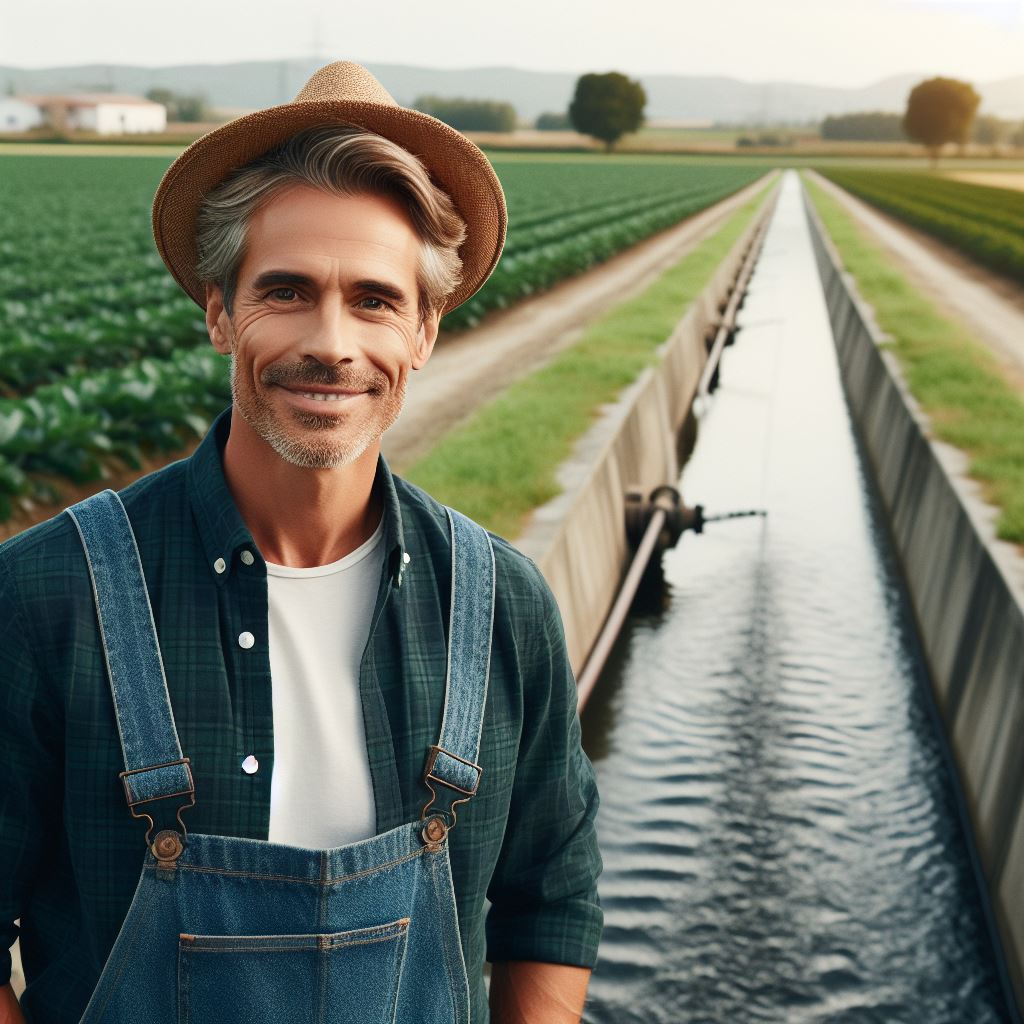Introduction
Sustainable irrigation techniques refer to methods that promote efficient water use and minimize negative environmental impacts. This is crucial for both agriculture and the environment.
Sustainable irrigation techniques are essential for agriculture as they help optimize water usage, reduce costs, and increase crop yields.
The environment also benefits from sustainable irrigation practices as they minimize water waste, prevent soil erosion, and protect natural water resources.
By employing sustainable irrigation techniques, farmers can ensure long-term agricultural productivity and mitigate the effects of climate change.
One key aspect of sustainable irrigation is the use of efficient irrigation systems, such as drip irrigation or precision sprinklers.
These systems deliver water directly to the plant roots, minimizing evaporation and water loss.
Water management techniques, such as soil moisture monitoring and scheduling irrigation based on crop needs, also play a crucial role in sustainable irrigation practices.
Moreover, implementing water-saving strategies like mulching, crop rotation, and improved soil management can further enhance the sustainability of irrigation practices.
The adoption of modern technologies, such as remote sensing and IoT devices, can assist farmers in monitoring and optimizing irrigation practices.
By embracing sustainable irrigation techniques, farmers can ensure the improved availability of water for future generations and reduce the overall water footprint of agriculture.
In short, sustainable irrigation techniques are vital for both agriculture and the environment.
By implementing these practices, we can achieve efficient water usage, enhanced crop yields, and reduced environmental impact.
Water Management
Inefficient water management can result in water scarcity and environmental damage.
Importance of efficient water management
Efficient water management is crucial for sustainable irrigation practices.
Precision technology and sensors can be used to accurately monitor and control water usage.
Transform Your Agribusiness
Unlock your farm's potential with expert advice tailored to your needs. Get actionable steps that drive real results.
Get StartedUse of precision technology and sensors for water management
By implementing water-saving techniques like drip irrigation and micro-sprinklers, water can be conserved.
Implementing water-saving techniques like drip irrigation and micro-sprinklers
Drip irrigation delivers water directly to the plant’s roots, minimizing evaporation and runoff.
Micro-sprinklers deliver water in a fine mist, reducing water waste caused by wind.
Proper scheduling of irrigation to avoid overwatering
Proper scheduling of irrigation is essential to avoid overwatering and waterlogging the soil.
Overwatering can lead to root rot, nutrient leaching, and the growth of harmful pathogens.
Soil moisture sensors can be used to determine when irrigation is needed, preventing excess water usage.
Irrigation scheduling should take into account factors such as crop water requirements and weather conditions.
Smart irrigation systems can automatically adjust watering patterns based on these factors.
Benefits offered by effective water management in irrigation
Effective water management in irrigation offers several benefits:
- Conservation of water resources: Proper water management ensures the sustainable use of limited water supplies.
- Improved crop productivity: By delivering water in a targeted manner, irrigation techniques optimize plant growth.
- Reduced energy consumption: Using water-saving techniques reduces the energy required for irrigation.
- Prevention of soil erosion: Proper water management prevents excessive runoff, protecting the soil from erosion.
- Minimized chemical leaching: Over-irrigation can cause excess nutrients and chemicals to leach into groundwater.
- Cost savings: Efficient water management reduces water bills and operational costs for farmers.
Tips for implementing efficient water management in irrigation
- Conduct a water audit to assess current usage and identify areas for improvement.
- Install soil moisture sensors to monitor soil moisture levels and avoid overwatering.
- Use weather data and evapotranspiration rates to determine irrigation scheduling.
- Invest in precision irrigation technology to optimize water application and minimize waste.
- Retrofit existing irrigation systems with water-saving devices like pressure regulators and flow meters.
- Educate farmers and irrigation professionals on the importance of efficient water management.
In fact, efficient water management is essential for sustainable irrigation practices.
By utilizing precision technology, implementing water-saving techniques, and proper irrigation scheduling, water resources can be conserved, crop productivity can be improved, and environmental impact can be minimized.
It is crucial for farmers and irrigation professionals to prioritize efficient water management to ensure a sustainable future for agriculture.
Read: Polycultures vs Monocultures in Farming
Soil Health and Moisture Conservation
The role of healthy soil in sustainable irrigation
Healthy soil plays a crucial role in the success of sustainable irrigation techniques.
By improving soil structure and water-holding capacity, farmers can optimize water usage and ensure long-term sustainability.
Incorporating Organic Matter
One effective method to enhance soil health is by incorporating organic matter into the soil.
Organic matter, such as compost or manure, helps improve soil structure, allowing it to better retain water.
By adding organic matter, farmers can increase the soil’s water-holding capacity, reducing the need for excessive irrigation.
This practice also promotes soil biodiversity, enhancing nutrient availability for plants.
Conservation Practices
Implementing conservation practices like cover cropping and mulching can also significantly contribute to soil health and moisture conservation.
Cover crops, such as legumes or grasses, protect the soil from erosion and minimize water evaporation.
They also enhance soil fertility by fixing nitrogen and reducing weed growth, reducing the need for irrigation and chemical inputs.
Mulching, meanwhile, involves covering the soil surface with organic materials like straw or wood chips.
Showcase Your Farming Business
Publish your professional farming services profile on our blog for a one-time fee of $200 and reach a dedicated audience of farmers and agribusiness owners.
Publish Your ProfileThis layer acts as a barrier, reducing evaporation, soil temperature fluctuations, and weed growth, while also preserving moisture.
Using Moisture Sensors
Another effective technique to conserve moisture is by utilizing moisture sensors.
These devices monitor the soil moisture levels, providing farmers with accurate data to make informed irrigation decisions.
By using moisture sensors, farmers can avoid over-irrigation, which not only wastes water but also harms the environment by depleting water sources and leaching nutrients from the soil.
These sensors detect the soil moisture content and transmit the information to the irrigation system, ensuring irrigation is only applied when necessary.
This technology enables farmers to optimize water usage, reducing costs and promoting sustainability.
The Benefits of Sustainable Irrigation Techniques
Adopting sustainable irrigation techniques that prioritize soil health and moisture conservation offers various benefits.
Firstly, it promotes water efficiency, ensuring that water resources are utilized responsibly and minimizing the impact on local ecosystems.
Additionally, sustainable irrigation helps mitigate the effects of drought.
By using methods that focus on retaining moisture, farmers can better withstand periods of water scarcity and maintain crop productivity.
Furthermore, sustainable irrigation techniques improve soil quality, enhancing its nutrient-holding capacity and overall fertility.
This, in turn, leads to healthier plants, increased yields, and improved crop quality.
Lastly, the adoption of sustainable practices can contribute to carbon sequestration and reduce greenhouse gas emissions.
By optimizing water usage, farmers can reduce energy requirements for irrigation, resulting in a more sustainable agricultural system.
In essence, incorporating organic matter, implementing conservation practices, and utilizing moisture sensors all contribute to soil health and moisture conservation in sustainable irrigation.
By prioritizing these techniques, farmers can optimize water usage, improve soil quality, and promote long-term agricultural sustainability.
Read: Biodiversity: Key to Sustainable Farms
Plant Selection and Placement
Choosing drought-tolerant plant varieties
Choosing drought-tolerant plant varieties can significantly contribute to sustainable irrigation practices.
By selecting plants that can withstand prolonged periods without water, water usage can be minimized while still maintaining a visually appealing landscape.
Grouping plants with similar water requirements
Grouping plants with similar water requirements is another effective technique to optimize water usage.
By creating designated zones based on water needs, irrigation systems can be set up to deliver the right amount of water to each zone, ensuring plants receive adequate moisture without wasteful overwatering.
Utilizing landscape design to optimize water usage and minimize runoff
Utilizing landscape design to optimize water usage and minimize runoff is crucial in sustainable irrigation.
Implementing practices such as contouring the land, creating swales, or constructing rain gardens can help capture and retain water, reducing the amount of runoff that enters storm drains or bodies of water.
Use of shade and windbreaks to reduce water evaporation
Another aspect to consider is the use of shade and windbreaks to reduce water evaporation.
By strategically planting trees or tall shrubs to provide shade, the soil underneath remains cooler, reducing water loss through evaporation.
Additionally, windbreaks can help prevent strong wind from drying out the soil and plants, further minimizing water loss.
When selecting plants for a sustainable irrigation system, it is important to consider various factors like local climate, soil composition, and sun exposure.
Native plants and adapted plant species are often well-suited to the local environment and typically require less water and maintenance once established.
It is also beneficial to choose plants that attract pollinators, promoting biodiversity and enhancing the overall ecological balance.
Incorporating mulch around plants can significantly reduce water evaporation, suppress weed growth, and maintain soil moisture levels.
Organic mulches, such as wood chips or straw, are especially effective at retaining moisture and improving soil health. Mulch also helps regulate soil temperature, preventing extreme fluctuations that can stress plants.
Regular monitoring and adjustment of the irrigation system are essential to ensure it meets the water requirements of the selected plant varieties.
Periodically checking for leaks, adjusting watering schedules based on weather conditions, and considering seasonal variations are all important practices to optimize water usage and minimize wastage.
In general, plant selection and placement play a crucial role in sustainable irrigation techniques.
By choosing drought-tolerant varieties, grouping plants with similar water needs, utilizing landscape design, and implementing shade and windbreaks, water usage can be optimized while still maintaining a visually appealing and functional landscape.
Incorporating mulch and regularly monitoring the irrigation system further enhance water efficiency, contributing to long-term sustainability.
By implementing these techniques, individuals can make a positive impact on water conservation and overall environmental stewardship.
Read: Renewable Energy in Agriculture Today

Rainwater Harvesting
Rainwater harvesting is a crucial technique for sustainable irrigation, offering numerous benefits for agricultural practices.
By designing and constructing efficient rainwater collection systems, farmers can optimize water resources in an eco-friendly manner.
Showcase Your Farming Business
Publish your professional farming services profile on our blog for a one-time fee of $200 and reach a dedicated audience of farmers and agribusiness owners.
Publish Your ProfileThis section will discuss the various advantages of rainwater harvesting, methods for designing and constructing rainwater collection systems, strategies for storing and distributing rainwater, and the integration of this technique with traditional irrigation methods.
Benefits of Rainwater Harvesting for Sustainable Irrigation
- Conservation of Water Resources: Rainwater harvesting helps in conserving water resources by maximizing the utilization of rainwater.
- Cost-Effective Solution: Implementing rainwater harvesting techniques can significantly reduce dependence on expensive water sources, such as underground wells or water utilities.
- Reduction of Soil Erosion: Capturing rainwater helps prevent soil erosion caused by excessive water runoff during heavy rainfall.
- Improved Crop Production: Sustainable irrigation with rainwater can enhance crop yield and quality, resulting in better agricultural outcomes.
- Minimal Environmental Impact: Rainwater harvesting promotes sustainable practices, reducing the ecological footprint associated with conventional irrigation methods.
Designing and Constructing Rainwater Collection Systems
- Determining Collection Surface: Select suitable surfaces like rooftops or impermeable land to collect rainwater efficiently.
- Installation of Gutters and Downspouts: Direct rainwater flow from the collection surface into a storage system through gutters and downspouts.
- Filtering and Filtration Systems: Use filters and screens to remove debris, leaves, and other pollutants from harvested rainwater.
- Storage Tanks or Cisterns: Install storage tanks/cisterns to store collected rainwater for later use during dry periods.
- Purification Systems (optional): In some cases, it may be necessary to purify rainwater using suitable treatment methods before using it for irrigation.
Strategies for Rainwater Storage and Distribution
- Proper Tank Maintenance: Regularly inspect and maintain storage tanks/cisterns to ensure they are clean and free from contamination.
- Use of Overflow Systems: Install overflow systems to redirect excess rainwater and avoid flooding or damage to collection infrastructure.
- Gravity-Based Distribution: Utilize gravity by placing storage tanks at elevated positions to distribute rainwater to lower-lying agricultural areas.
- Drip Irrigation Systems: Employ drip irrigation techniques to efficiently distribute harvested rainwater directly to plant roots, minimizing water loss.
- Smart Irrigation Controllers: Utilize advanced technology like smart irrigation controllers to manage and optimize the use of stored rainwater.
Integration of Rainwater Harvesting with Traditional Irrigation Methods
- Supplementing Existing Water Sources: Incorporate rainwater harvesting as an additional water source to supplement traditional irrigation methods.
- Optimal Utilization: Use rainwater during periods of sufficient rainfall to reduce reliance on conventional irrigation sources.
- Combination with Greywater: Greywater, such as wastewater from household activities, can be combined with harvested rainwater for irrigation purposes, further reducing water consumption.
In brief, rainwater harvesting is an invaluable technique for achieving sustainable irrigation.
Its benefits include water resource conservation, cost-effectiveness, reduced soil erosion, improved crop production, and minimal environmental impact.
By following proper design and construction practices, implementing effective storage and distribution strategies, and integrating this technique with traditional irrigation methods, farmers can optimize their water usage and contribute to a more sustainable future.
Read: Urban Permaculture: City Farming Guide
Smart Irrigation Systems
Smart irrigation systems have revolutionized the way we manage water resources in agriculture.
These systems utilize cutting-edge technologies to optimize irrigation efficiency and reduce water waste.
In this section, we will explore the various components and benefits of smart irrigation systems.
Introduction to Smart Irrigation Technologies
Smart irrigation technologies encompass a range of innovative tools and techniques that enable precise and targeted water delivery to plants.
These technologies leverage real-time data and automation to make irrigation processes more efficient and sustainable.
Use of Weather-Based Controllers and Sensors
Weather-based controllers are an essential component of smart irrigation systems.
These controllers use weather data, such as temperature, humidity, and rainfall, to adjust irrigation schedules and amounts accordingly.
By considering current environmental conditions, these controllers prevent overwatering and ensure plants receive just the right amount of water they need.
Sensors play a crucial role in smart irrigation systems. Soil moisture sensors measure the moisture levels in the soil, providing real-time data to the controllers.
This information helps optimize irrigation scheduling and prevents waterlogging or drought stress in plants.
Other sensors, such as rainfall sensors, can override irrigation schedules when sufficient rainfall occurs, further reducing water waste.
Automation and Remote Monitoring
Smart irrigation systems feature automation and remote monitoring capabilities, allowing farmers to efficiently manage their irrigation processes.
Automation eliminates the need for manual intervention by controlling irrigation valves and pumps based on sensor readings and pre-set parameters.
This reduces labor requirements, saves time, and ensures accurate water delivery.
Remote monitoring enables farmers to monitor and control their irrigation systems from anywhere, using smartphones or computers.
This technology provides real-time updates on system performance, alerts for malfunctions, and the ability to make adjustments remotely.
Farmers can respond promptly to issues, saving water and preventing crop damage.
Benefits of Smart Irrigation
The adoption of smart irrigation systems offers numerous advantages in terms of water conservation and agricultural productivity:
- Water Conservation: Smart irrigation systems minimize water waste through precise scheduling and distribution, reducing water usage and environmental impact.
- Optimized Irrigation Efficiency: By considering real-time data, smart systems deliver the right amount of water at the right time, improving plant health and yield.
- Cost Savings: Efficient water usage leads to reduced water bills, lower energy costs, and less maintenance for irrigation equipment.
- Precise Nutrient Delivery: Smart irrigation systems can integrate fertilizer injectors, ensuring accurate nutrient application based on plant requirements.
- Disease Prevention: Proper irrigation control helps prevent water-related diseases by minimizing excessive moisture on foliage.
- Environmental Sustainability: By conserving water resources and reducing chemical runoff, smart irrigation systems contribute to overall environmental sustainability.
In a nutshell, smart irrigation systems offer a sustainable and efficient approach to water management in agriculture.
Leveraging weather-based controllers, sensors, automation, and remote monitoring, these technologies significantly reduce water waste while optimizing irrigation efficiency.
The benefits of smart irrigation extend beyond water conservation, encompassing enhanced crop productivity, cost savings, and environmental sustainability.
Conclusion
We have explored a range of sustainable irrigation techniques that can revolutionize the way we use water in farming and gardening.
Through the implementation of these practices, we can create a more sustainable future for our agricultural systems.
By adopting techniques such as drip irrigation, rainwater harvesting, soil moisture sensors, and crop rotation, we can ensure efficient water usage while minimizing wastage.
These methods not only conserve water but also reduce energy consumption and minimize the use of harmful chemicals.
Long-term benefits of such sustainable practices include improved soil health, increased crop yields, and reduced environmental impact.
By promoting water conservation and preservation, we can protect our precious water resources, ensuring their availability for future generations.
It is essential to encourage farmers and gardeners to integrate these sustainable irrigation techniques into their practices.
By doing so, we can create a significant impact on water savings, preventing water scarcity and promoting a healthier ecosystem.
Moreover, governmental support, funding, and educational programs must be provided to empower agricultural communities to implement these practices effectively.
Collaboration between researchers, policymakers, and farmers is crucial to develop innovative solutions and overcome challenges in sustainable irrigation.
Let us embrace these sustainable irrigation techniques and work towards a more sustainable future.
Each effort counts towards ensuring water security, increasing food production, and preserving our environment.
Together, we can make a difference and contribute to a more sustainable and resilient planet.




